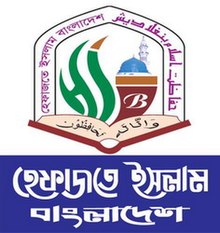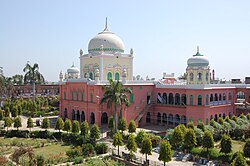|
Hefazat-e-Islam Bangladesh
Hefazat-e-Islam Bangladesh (Bengali: হেফাজতে ইসলাম বাংলাদেশ, lit. 'Protection of Islam, Bangladesh') is an Islamist advocacy group consisted mostly of religious teachers (Ulama) and students in Bangladesh.[2][3][4][5][6] The group is mainly based on qawmi madrasas in Bangladesh. In 2013, they submitted a 13-point charter to the government of Bangladesh, which included the demand for the enactment of a blasphemy law.[7][8] Under recent years, Hefazat has been formed into more of a moderate and anti-terrorist ideology due to success of Awami League in ensuring jobs and mobilising qawmi madrasa.[9] History Hefazat-e-Islam was formed in 2010, as a pressure group comprising the teachers of several madrasas at Chittagong, Bangladesh.[4] Shah Ahmad Shafi, the former director of Hathazari Madrasa, Allama Junaid Babunagari, and Mufti Izharul Islam, the chairman of the Islamist party Islami Oikya Jote, Abdul Malek Halim, founder and principle of the first women Qawmi madrasah (Haildhar Madrasah) in Bangladesh are regarded as the founders of Hefazat-e-Islam.[2][10][11] The formation was allegedly triggered by the 2009 "Women Development Policy" draft.[12] On 24 February 2010, Hefazat wanted to hold a rally at Laldighi Maidan, Chittagong to protest the government's move to slap a ban on religion-based politics, cancellation of the fifth amendment to the Constitution of Bangladesh, and a proposed education policy that would have ended madrasah education.[2][3] The police refused their request to hold a rally and injured 19 protesters.[2] A few of these madrasa students were arrested by police and later released.[13] In 2011, Hefazat-e-Islam protested some aspects of the proposed Women Development Policy.[14][15] According to The Economist, Hefazat was financed by doctrinaire Islamists in Saudi Arabia.[16] 13-point demand agitationIn 2013, Hefazat-e-Islam was reformed after the allegation that some of the protesters in the Shahbag protests were involved in publishing of content offensive to Muslims on blogs,[17] including the depiction of the Islamic prophet Muhammad as a pornographic character.[18] They arranged a rally towards capital city Dhaka, demanding enaction of capital punishment of the "atheist bloggers" involved in the Shahbag movement and a blasphemy law.[19][20][21] They included their demands in 13 points which included:[22]
Long march in April 2013On 6 April 2013, Hefazat-e-Islam organised a long march towards the Motijheel area in Dhaka from Chittagong, Sylhet and Rajshahi to push for their 13-point demand.[24] This was dubbed by some in the media as the "Siege of Dhaka".[25] Awami League leader Nowsher Khan died of head injuries during a clash between his party activists and those of Hefazat-e Islam at Bhanga in Faridpur district.[26] Hefazat supporters also attacked at a rally of Ekatturer Ghatak Dalal Nirmul Committee in Dhaka from their procession, injuring several people including a policeman.[27] Hefazat supporters also attacked and injured Afsar Ahmed, the pro-vice chancellor of Jahangirnagar University,[28] and reportedly threatened journalists.[29][30] 5–6 May protestsOn 5 May 2013, Hefazat arranged a rally in Dhaka, in the demand of their 13 points.[31] On 4 May 2013, Hefazat activists gathered at all six entrance routes to Dhaka; creating a blockade, from dawn on 5 May 2013.[18] At noon, with the permission of Dhaka Metropolitan Police (DMP), activists entered Dhaka and started moving towards Baitul Mukarram National Mosque in order to attend a prayer service.[18] However activists of Hefazat-e- Islam were attacked by the ruling Awami League activists at various places using lethal arms such as pistols and guns who were using the Gulistan Road to reach Shapla Square.[18][32] In return, Hefazat activists threw bricks at them.[18] During the clashes, two television journalists were injured, apparently by Hefazat protesters.[33] At about 3:00 pm while Hefazat leaders were delivering speeches, the Secretary General of Awami League, Sayed Ashraful Islam, at a press conference, threatened them to leave Dhaka.[18] On the other hand, the opposition party Bangladesh Nationalist Party (BNP) asserted that Hefazat members had a democratic right to assemble and articulate their cause.[18] Hefazat supporters reportedly set fire to book stores located beside the south gate of the Baitul Mukarram during their program, inadvertently burning copies of Qurans,[34] and assaulting two reporters.[33] However, reports of this event are disputed,[35] and Hefazat denies burning any books.[11] According to BNP leader MK Anwar, the Qurans were burned by Debashish, a leader of the ruling party Awami League's volunteer wing, the Swechchhasebak League.[25] Hefazat also denies the violent incidents of vandalism and arson attributed to it.[11] In the early hours of 6 May security forces, drawn from police, the elite Rapid Action Battalion and paramilitary Border Guard Bangladesh jointly launched an operation named "Operation Secure Shapla" to prevent Hefazat's violence by driving them out from Dhaka.[36][37][38] At the beginning of operation, police cut the power supply in the city's commercial area, but the total operation was live telecasted over few TV channel.[39] During the course of the operations, two television channels, Diganta Television and Islamic TV, were shut down.[40][41] CasualtiesAccording to government estimates, the number of casualties in this operation was 11, including a few law enforcement members,[42] while the Daily Star gave as little as 5 deaths.[43] This figure was dismissed by Human Rights Watch and other news agencies.[44] Hefazat and the BNP initially claimed that 2,000-3,000 had been killed in the operations.[37] British journalist confirmed that at least 36 people had died.[45][46] which is also rejected by government. According to The Economist, European diplomats, as many as 50 people were killed in Dhaka, which didn't provide any diplomat's name.[41][46] Because of the differing views, Human Rights Watch called for an independent body to investigate the protest deaths.[45][46][47] the poet and activist Farhad Mazhar said the government and media were making a cover-up and disinformation campaign.[48] Human Rights Watch disputed opposition claims of 200 deaths, but agreed that a massacre had occurred.[32][42][49] Amnesty International demanded that Bangladesh government set up an independent and impartial investigation immediately to look into police excesses.[25] UN Secretary-General Ban Ki-moon voiced concern over the killing of unarmed protesters in Bangladesh and requested the government to sit with religious and political leaders.[43] On 6 May, the protests spread across the country. In Narayanganj, students and teachers of a local madrasa held protests and blockaded the Dhaka-Chittagong highway.[50][51][52] In return, police fired several hundred gunshots, killing 27 people. In Hathazari Upazila, Chittagong, six people were shot dead by police. In Bagerhat, one Hefazat member died in a clash between protesters and police.[50] LawsuitsThe government filed 12 cases against top leaders of the Hefazat-e Islam for murder, vandalism, arson and destruction of properties and other charges,[53] after a demand for impartial investigations from supporting organisations.[54] In 2014, a case was filed with the International Criminal Court against 25 Bangladeshi ministers and security officials, including Prime Minister Sheikh Hasina for alleged torture, forced disappearance, extrajudicial executions and mass killings.[55] Secularism lawsuitIn 2016 secular activists led by Anisuzzaman submitted a petition to remove Islam as the state religion.[56] They argued that since secularism was one of the four fundamental principles of the first 1972 constitution, it should be reinstated.[57] Secularism was removed from the constitution in 1975, and Islam was made the state religion in 1988, during the term of Hussain Mohammad Ershad as president.[58] In 1988, few secular minded citizens of Bangladesh had filed a petition to restore the secularism in the constitution.[59] On 27 March 2016, a Bangladeshi court accepted a petition to remove Islam as the state religion.[58] Hefazat-e-Islam reportedly had threatened armed resistance if Islam was dropped as the state religion.[60] The court rejected the petition, stating that those who brought it forward did not have the right to do so.[61] A lawyer and Hefazat spokesperson argued that having Islam as the state religion would not affect minority religions.[56] They also noted that the petition was unnecessary as Bangladeshi Muslims were respectful of minority religions and "set a tremendous example of communal harmony even after having Islam as state religion."[61] Lady Justice statueIn 2017 supporters of Hefazat-e Islam protested against the display of a figure of the Greek goddess of justice at Bangladesh Supreme Court, calling it a measure and conspiracy to undermine Islam in Bangladesh.[62] Hefazat-e-Islam later petitioned the Supreme Court to remove the statue, which was supported by the Awami League-backed Bangladesh Awami Olama League and a news editor.[63] 2021 anti-Modi protestsOn the news of arrival of Narendra Modi during Bangladesh golden jubilee of the independence celebrations on 26 March. Accusing Modi of being anti-Muslim, Hefazat-e-Islam started protesting against invitation of Modi.[64][65][66] 26-28 March protestsAfter the arrival of Narendra Modi in Bangladesh, Hefazat-e-Islam supporters gathered at Baitul Mukarram National Mosque, Dhaka on 26 March after the Friday prayer. During the protests, a deadly conflict started when supporters of Awami League tried to stop the protesters from waving their shoes as a sign of disrespect to Modi. This resulted in violent clashes from both sides. Protesters were dispersed by police using tear gas and rubber bullets injuring scores of people. After the incident, the violence then spread to several key districts in the country.[67] The attack in Baitul Mukarram infuriated students at Hathazari of Chittagong, the stronghold of Hefazat students. Students came out in the street to protest the attack on their fellows. The demonstration was obstructed by police while passing the Hathazari Police Station. Protesters started attacking police stations, and public properties, prompting police to open fire. Four protesters died in the process.[68] To stop the spread of news and cut off communication across the country, the government of Bangladesh blocked Facebook on March 26, from the afternoon.[69] Hundreds of Hefazat demonstrators returned to the streets of Dhaka on Saturday. Clashes were reported from many parts of the country. Brahmanbaria is widely affected by the violence. Hefazat supporters attacked train and government offices.[70] Five more people were killed on Saturday.[69] Meanwhile, Facebook and its instant messaging app, Facebook Messenger, were kept blocked across the country on Saturday.[71] IdeologyRifat Binte Lutful urged that although it started as a fundamentlist group, later it began to drift towards moderate Islamism with Awami League administration recognising qawmi madrasah degrees and forming an anti-radical unity.[72] Controversy
Allegations of links with Jamaat-e-IslamiThe Awami League government alleged that Hefazat is front for Bangladesh Jamaat-e-Islami and seeks to derail the International Crimes Tribunal for the war crimes committed in 1971.[73] Hefazat denies any role with Jamaat-e-Islami,[2] and alleged that this is a libel to subjugate Islamists in public life.[18] Analysts also say that any relationship claim is baffling as Ahmad Shafi belongs to a band of Islamists that, unlike Jamaat, did not oppose the independence of Bangladesh, and supported a united India and rejected the creation of Pakistan in 1947.[12] Allegations of links with pro-Taliban leadersMaulana Habibur Rahman, a madrasa principal of Sylhet and one of the organisers of Hefazat-e Islam's 5 May protest, claimed that he met Osama bin Laden and members of the banned militant organisation Harkat-ul-Jihad al-Islami, in 1998.[74] However, Hefazat leaders have condemned Harkat-ul-Jihad al-Islami and Al-Qaeda and its leader Ayman al-Zawahiri.[75] In 2014, Hefazat spokesman Azizul Haque Islamabadi said:[75][76]
The German ambassador to Bangladesh Albrecht Conze opined that Hefazat demands fundamentalism in Bangladesh.[77] However, in 2014, diplomats from the American embassy in Bangladesh met with the leaders of Hefazat and discussed their demands.[78] Explosion at affiliated madrasaOn 7 October 2013, an explosion occurred at a madrasah run by Hefazat-e-Islam's leader Mufti Izharul Islam Chowdhury driven Al Jamiatul Ulum Al Islamia Madrasa at Lal Khan Bazar, Chittagong.[79][80][81] Police reportedly seized explosives after the raid.[79][80] The madrasa authorities had claimed that computers' UPS of the school and laptops had exploded.[79] See alsoReferences
Further reading
External links
|
||||||||||||||||||||||||||||||||||||||

